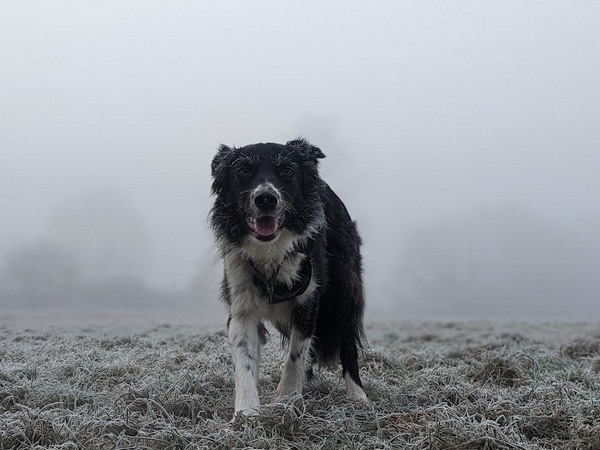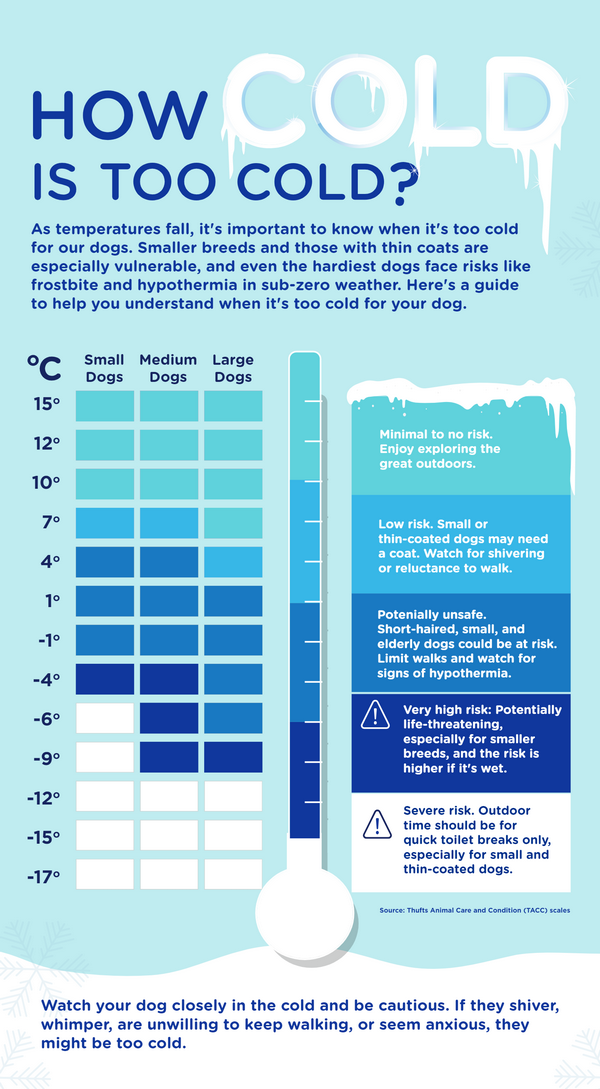What is a safe temperature to walk a dog?
Walking your dog is more than just a daily routine — it's essential for their health and wellbeing. But, as the temperature drops, knowing when it's safe to take your dog out for a stroll is important.
This article will guide you through everything you need to know about keeping your dog safe in cold weather.
Factors to consider
Knowing the right temperature for walking your dog is key to keeping them safe. While there's no one-size-fits-all answer, you can follow some general guidelines.
| Factor | Considerations for dogs |
|---|---|
| Wind chill | Wind chill describes how cold it feels with the wind, affecting the perceived outside temperature. Even a mild breeze can significantly lower the felt temperature. It's important to check temperature apps like the Met Office to understand the real-feel temperature. This is crucial in deciding whether it's too cold to take your dog for a walk, especially for breeds less tolerant to cold. |
| Dog's coat | Dogs' tolerance to cold varies with their coat type. Thick-coated breeds like Huskies and Newfoundlands are more equipped to handle cold weather compared to thin-coated breeds like Whippets or Greyhounds. For dogs with thin coats, consider a winter jacket to provide extra warmth during outings in the cold. |
| Age and health | Puppies, senior dogs, and those with health issues may have a harder time coping with cold weather. They are prone to getting cold quicker and are at a higher risk of health problems like hypothermia. Extra care and precautions are necessary for these dogs during cold weather to ensure their well-being. |
| Size of your dog | Size plays a significant role in how dogs handle the cold. Smaller dogs tend to lose heat faster than larger ones and being closer to the ground, they are more affected by the cold surface. This is particularly true for breeds with low bodies, like Dachshunds and Basset Hounds, who may need additional protection against the cold. |
What dogs are built for the cold?
Like us, dogs can get cold, and not all dogs are built for cold weather. The right temperature for a walk can vary a lot depending on what type of dog you have.
Dogs that generally cope well with the cold are:

Working breeds like Border Collies, Labrador Retrievers and English Sheepdogs are also well suited to colder temperatures.
When the temperature drops, some dogs struggle more than others. These dogs may include:
- Greyhound
- Whippet
- Italian Greyhound
- Chihuahua
- Chinese Crested Powder Puff

How cold is too cold for puppies
Because puppies haven’t yet fully developed and have less body fat than adult dogs, they cannot keep themselves as warm. They also lose body heat much more quickly than adult dogs, which makes them more susceptible to cold temperatures. Puppies are still getting accustomed to the world, including the weather, and may not know how to react to the cold. In winter weather, it’s important to monitor them and ensure they are safe and warm.
Avoid taking your puppy for a walk if the temperature drops below 0°C. Even at temperatures slightly above freezing, it's important to keep an eye on your puppy to ensure they're not showing any signs of being too cold. It's best to keep outdoor trips short and limit them to potty breaks and quick play sessions. If you’re in any doubt, keep them indoors.
Protecting your dog in cold weather
Using the right clothing and gear can make a big difference, and gradually getting your dog used to the cold can also help.
Dog clothing and gear for cold weather
Coats and sweaters
A good coat or sweater can be a game-changer for dogs, especially those with short hair. Look for something that covers the neck to the base of the tail and the belly. There is a huge selection on the market, and although some are cheaper than others, investing well will save you money down the line.
Boots
Dog boots can protect your dog's paws from cold surfaces, ice, and salt. It might take some time for your dog to get used to them, but they can greatly help with patience and practice. One annoying thing about dog boots is they normally only come in sets of two, which isn’t ideal for our four-footed friends.
Reflective gear
In winter, it gets dark earlier. Reflective collars, leashes, or jackets can help keep your dog visible during evening walks. You should also be visible.
Getting your dog used to colder temperatures
If you plan to take your dog for a walk in low temperatures, you should start with short walks and gradually increase the time spent outside. This way, your dog can get used to the colder weather slowly. Keeping your dog moving during the walk helps generate body heat and will keep them warm.
Be attentive to your dog's reactions to the cold weather. If they seem uncomfortable, it's best to go back inside. After a cold walk, give your dog a cosy blanket or a warm spot away from drafts to help them warm up.

Need more advice
For more information on keeping your dog safe in the cold, speak to your local vet or vet nurse.
Find your nearest vet using our find a vet page, or speak to one of our vets online using our video vets service.


